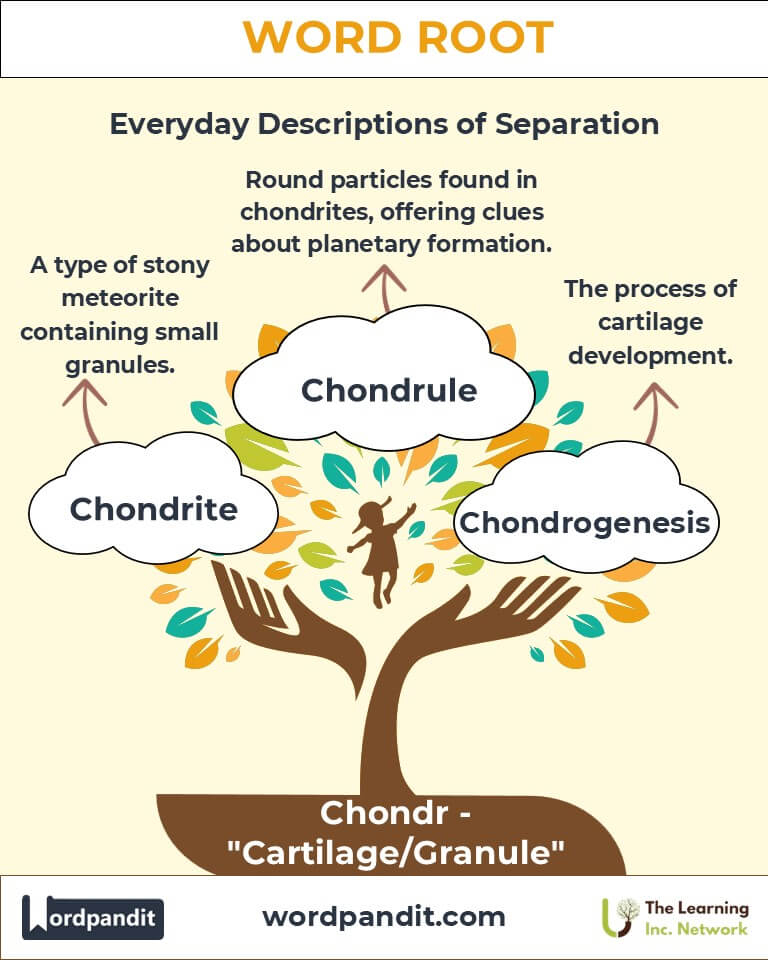Chondr: The Foundation of Cartilage in Language and Science
Discover the intriguing world of the word root "chondr," derived from the Greek word "khondros," meaning cartilage or granule. This root enriches medical and scientific terminologies, providing essential insights into anatomy and beyond.

Table of Contents
- Introduction: The Essence of "Chondr"
- Etymology and Historical Journey
- Mnemonic: Unlocking the Power of "Chondr"
- Common Chondr-Related Terms
- Chondr Through Time
- Chondr in Specialized Fields
- Illustrative Story: "Chondr" in Action
- Cultural Significance of the "Chondr" Root
- The Chondr Family Tree
- FAQs about the Chondr Word Root
- Test Your Knowledge: Chondr Mastery Quiz
- Conclusion: The Living Legacy of "Chondr"
Introduction: The Essence of "Chondr"
Pronounced as "kawn-druh", the root "chondr" originates from the Greek word khondros, referring to cartilage or a small granule. This foundational term has shaped medical vocabularies, playing a vital role in describing structures and conditions of the body. From studying the skeletal framework to understanding disorders, "chondr" highlights the importance of cartilage in maintaining mobility and health.
Etymology and Historical Journey
"Chondr" emerged from ancient Greek, where khondros was used to describe both cartilage and granule-like structures. Its dual meaning underscores the granulated appearance of cartilage tissue under early microscopes. Over centuries, the root evolved into various forms in anatomy, paving the way for terms that describe both structure and dysfunction.
Mnemonic: Unlocking the Power of "Chondr"
Think of "chondr" as the cushion in your joints! Visualize cartilage as a soft pillow protecting bones during movement. This image of flexibility and support connects directly to the root’s meaning.
Mnemonic Device: “Chondr cushions your bones, keeping movement smooth and groans unknown!”
Common Chondr-Related Terms
- Chondrite (kawn-drite): A type of stony meteorite containing small granules.
Example: "Scientists analyzed a chondrite to study the early solar system."
- Hypochondria (hy-poh-kawn-dree-uh): Excessive worry about health, historically linked to the region beneath the rib cartilage.
Example: "Her constant visits to the doctor were a result of hypochondria."
- Chondrocyte (kawn-droh-site): A cell responsible for cartilage formation.
Example: "Chondrocytes play a critical role in repairing joint damage."
- Osteochondritis (os-tee-oh-kawn-drye-tis): Inflammation of cartilage and bone.
Example: "Athletes are prone to osteochondritis from repetitive joint stress."
- Chondroma (kawn-droh-muh): A benign tumor composed of cartilage.
Example: "The surgeon successfully removed the chondroma from her wrist."
Chondr Through Time
- Ancient Roots: In early Greek medicine, "khondros" referred to cartilage, integral to theories about the body's flexibility.
- Modern Science: With advanced imaging and research, "chondr" now defines critical processes in cartilage biology and pathology.
Chondr in Specialized Fields
- Anatomy:
- Chondrogenesis: The process of cartilage development.
Application: Crucial in embryology and regenerative medicine.
- Chondrogenesis: The process of cartilage development.
- Astronomy:
- Chondrule: Round particles found in chondrites, offering clues about planetary formation.
Example: "Chondrules provide a window into the origins of the solar system."
- Chondrule: Round particles found in chondrites, offering clues about planetary formation.
- Medicine:
- Chondromalacia: Softening of cartilage, often in the knee.
Importance: Diagnosing and treating this condition prevents long-term joint damage.
- Chondromalacia: Softening of cartilage, often in the knee.
Illustrative Story: "Chondr" in Action
Alex, a promising athlete, began experiencing knee pain after rigorous training. His doctor diagnosed him with chondromalacia, a condition where cartilage softens. With proper therapy and chondrogenic supplements, Alex’s knees regained strength, allowing him to pursue his passion pain-free. This journey illustrates the importance of understanding cartilage health and the role of "chondr" in medicine.
Cultural Significance of the "Chondr" Root
The word root "chondr" bridges diverse fields, from health to the cosmos. Its use in describing cartilage ties directly to human anatomy and movement, while terms like "chondrite" connect it to the stars. Across cultures, cartilage-related disorders have historically influenced medical practices and innovations.
The Chondr Family Tree
- Osteo (bone):
- Osteochondritis: Inflammation of bone and cartilage.
- Cyto (cell):
- Chondrocyte: A cell forming cartilage.
- Malacia (softening):
- Chondromalacia: Cartilage softening.
FAQs About the "Chondr" Word Root
Q: What does "chondr" mean?
A: The root "chondr" derives from the Greek word khondros, meaning cartilage or granule. In medical contexts, it typically refers to cartilage, the flexible connective tissue found in joints, ribs, and other parts of the body. It can also be used in non-biological contexts, like in "chondrite," where it refers to granular structures found in meteorites.
Q: What is hypochondria, and how does it relate to "chondr"?
A: Hypochondria is excessive anxiety about one’s health. Historically, the term was linked to the region beneath the rib cartilage (the hypochondrium), as ancient physicians believed many physical and emotional issues originated in this area. This anatomical association led to the term becoming synonymous with health-related anxiety.
Q: What are chondrites?
A: Chondrites are a type of stony meteorite that contain small, round granules called chondrules. These are among the oldest materials in the solar system, providing valuable information about the early stages of planetary formation. Despite the anatomical origin of "chondr," this term highlights its versatility in describing granular structures.
Q: What is a chondrocyte, and why is it important?
A: A chondrocyte is a specialized cell responsible for producing and maintaining cartilage. These cells secrete the extracellular matrix that gives cartilage its structure and resilience, playing a vital role in joint function and repair. Damage or degeneration of chondrocytes is associated with conditions like osteoarthritis.
Q: How does "chondr" relate to medical terminology?
A: The root "chondr" is central to many medical terms related to cartilage and its disorders. Examples include "chondromalacia" (cartilage softening), "osteochondritis" (inflammation of cartilage and bone), and "chondroma" (a cartilage tumor). These terms help describe various diseases and treatments in anatomy and orthopedics.
Test Your Knowledge: "Chondr" Mastery Quiz
1. What does "chondr" refer to?
2. Which term describes a cartilage-forming cell?
3. What is a chondrite?
4. What is osteochondritis?
5. Where does the term "hypochondria" originate?
Conclusion: The Living Legacy of "Chondr"
From ancient Greece to modern medicine, "chondr" remains central to understanding cartilage and its role in health and science. As research advances, this root continues to inspire new insights into anatomy, astronomy, and beyond. By exploring "chondr," we connect the micro (cartilage) with the macro (the universe), underscoring its enduring relevance.











